the history of yeovil's pubs
PUBS HOME PAGE |
PUBS INTRODUCTION |
PUBS BY NAME |
BEERHOUSES |
george inn (1)
High Street
The George Inn (marked 'E' on the map below) was an inn during the 16th and 17th centuries situated in High Street, but not to be confused with the more well-known George Hotel in Middle Street which was, at this time, known as the Three Cups Inn.
The George Inn under discussion here was mentioned as early as 1568 in the Churchwarden's Accounts of St John the Baptist, later in the 1664 Rate Book and again in the Portreeve's Accounts for 1669. It is not known how long the George Inn of High Street traded for but was probably closed by the end of the 18th century and it is likely that the Three Cups Inn in Middle Street was renamed the George some time afterwards. The building shown in the photographs below was probably not the original George Inn building, but may have been a later rebuild of the inn or a rebuild as a completely new retail building.
In 1618 an order was made that only nine licensed premises be allowed in the borough (that is the town, not that part of High Street today called the Borough) and two outside, with the rest being 'suppressed'. The George was undoubtedly one of the nine 'allowed' premises.
During the latter part of the eighteenth century the George Inn was one of a group of licensed premises along the short stretch of High Street. Then, of course there was the Angel Inn and the seven clustered at the western end of South Street as seen in the map above, as well as four in Silver Street and at least five in Grope Lane (Wine Street). I wonder if anyone ever made the grand tour and managed to venture into the pubs in Middle Street afterwards?
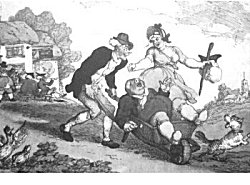 John
Goodchild, in
his book 'The
Borough of
Yeovil' recalls
that in 1654 a
petition was
made in Yeovil
against the
vicar, the
Reverend William
Parsons
"...,that one
Parson Townsende
(and the said Mr
Parsons) having
been drinkinge
att the George
in Yeoville
about 2 years
since were both
distempered with
beere for so
much that the
sayd Mr
Townsende was
helpen up out of
the dirt in ye
streete...". However,
respectable
drunkenness was
very much a part
of seventeenth
and eighteenth
century life and
the vicar's
drunkenness
would more often
have been viewed
with hilarity
rather than any
sense of
disapproval or
reproach.
John
Goodchild, in
his book 'The
Borough of
Yeovil' recalls
that in 1654 a
petition was
made in Yeovil
against the
vicar, the
Reverend William
Parsons
"...,that one
Parson Townsende
(and the said Mr
Parsons) having
been drinkinge
att the George
in Yeoville
about 2 years
since were both
distempered with
beere for so
much that the
sayd Mr
Townsende was
helpen up out of
the dirt in ye
streete...". However,
respectable
drunkenness was
very much a part
of seventeenth
and eighteenth
century life and
the vicar's
drunkenness
would more often
have been viewed
with hilarity
rather than any
sense of
disapproval or
reproach.
In his 1684 will, William Phelps recorded "All my right title and Interest which I have or ought to have of ... the George Inne in Yeovell aforesaid".
An
indenture dated
5 December 1839
in my
collection,
recorded "...
All that
Messuage
Tenement and
Dwelling house
situate and
standing in
George Court
consisting of
Two rooms on the
Ground Floor two
Chambers on the
First Floor one
of which is over
the Hall and the
other over the
Brewhouse and on
the Attic Story
or Second Floor
two Chambers and
also the Shop
next to the
Street and the
Cellar under the
Shop All which
said Premises
are situate
lying and being
within the
Borough of
Yeovil aforesaid
and were
formerly parts
or parcels or
reputed parts or
parcels of a
Burgage or
Tenement called
or known by the
name of the
George Inn
The former George Inn was occupied by George Crocker's ironmongery business from 1840 to 1850, then by James Corfield's ironmongery business, from 1850 until 1869, when the property became Denner and Stiby's ironmongery business until 1892. It then became George Llewellyn's greengrocery and florist premises. This building had rooms over an archway that was the entrance to George Court. The site, including the adjacent Borough House (the former Bell Inn), was demolished for the construction of municipal offices and King George Street, completed by 1928.
map
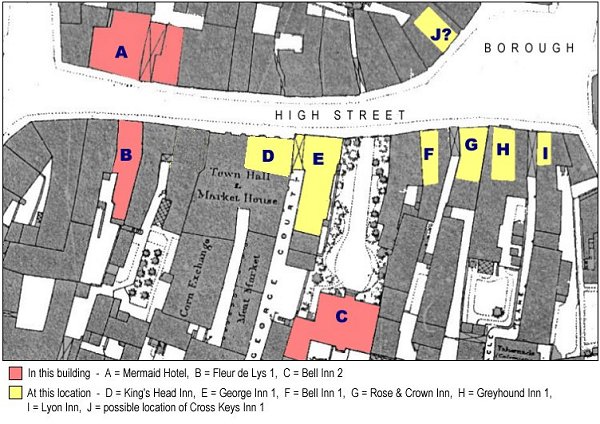
gallery
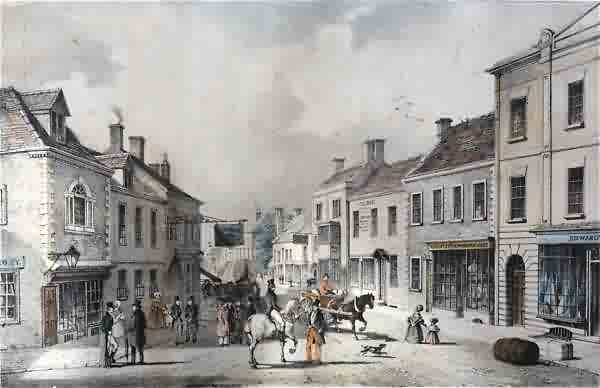
From my
collection
This lithograph looks down High Street from its junction with Hendford / Princes Street. On the left the Mermaid with its familiar archway and large overhanging sign is clearly seen. On the opposite side of the road, just right of centre, the white three storey building with the two-storey projecting bay is the Kings Head Inn. It is likely that the two storey building next to the Kings Head Inn is the building that held the former George Inn.
This hand-tinted stone lithograph was by Henry Burn (1807-1884) entitled 'Market Place - Yeovil'. There are not many known stone lithographs by Henry Burn because he left for Australia in 1852. It was published by William Porter and Henry Marsh Custard in January 1839 and printed by Charles Joseph Hullmandel (1789-1850) of London, where he maintained a lithographic establishment on Great Marlborough Street from about 1819 until his death.
For a more detailed account of the buildings in this 1839 lithograph, click here.
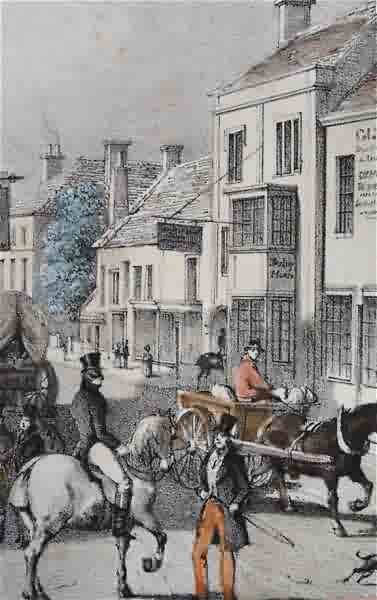
From my
collection
Enlarged from the lithograph above, it is possible that the building to the right of the tree was the former George Inn. However the last record of the George Inn was in 1770 and certainly by 1826 the inn formerly known as the Three Cups in Middle Street was known as the George Hotel.
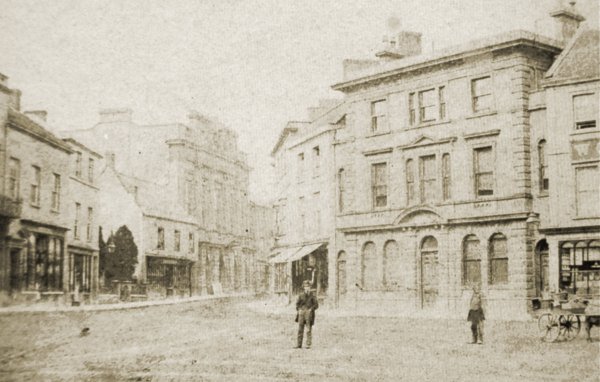
This photograph (clearly 'touched up' by the photographer) was taken around 1860. The large building at centre is the Town Hall that was built in 1849. Note that the Town Hall lacks the clock tower seen in the next photograph as this was only added in 1864. The two-storey building to its left stands on the site of the George Inn (possibly even the original George Inn building) with its first floor projecting over the alleyway known as George Court between the George Inn and the Town Hall. To the left of the George Inn building the gap is the garden area of the Bell Inn, later filled with a tall tree.
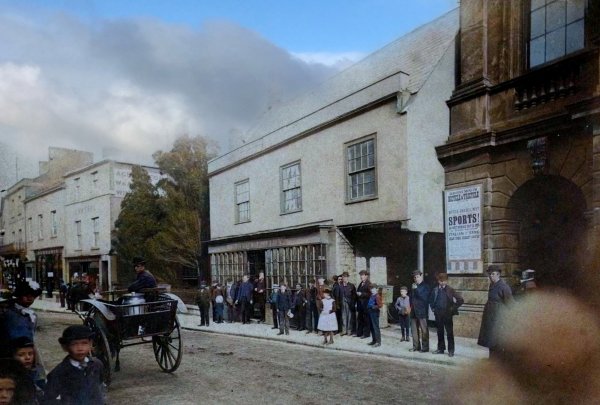
From the Stiby
Collection
(colourised),
Courtesy of South Somerset Heritage Collection
The site of or, more likely, the building of the George Inn, by this time housing Denner & Stiby's shop. Photographed in 1883, by Henry Stiby who was a keen amateur photographer and left a good record of photographs of Yeovil. Note under the right of the three first floor windows, is the entrance to the less-than-savoury George Court (see next photo).
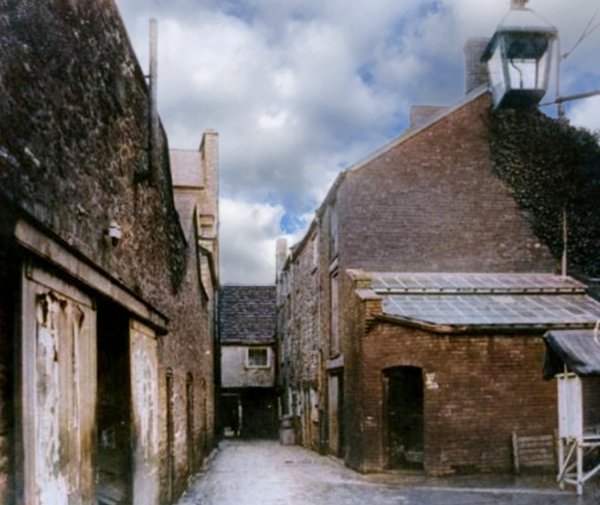
This
colourised photograph
features in my
book 'Secret Yeovil'.
This photograph dates to about 1915 and looks north along George Court towards High Street with the meat market at left and (by this time) slum housing at right, but originally part of the George Inn. At the end the 'flying freehold' that had also been part of the George Inn, is built over the tiny entrance to George Court. To the right the Court widens, as seen on the above map, towards the Bell Inn or, as it was called in 1886, the Borough Hotel.
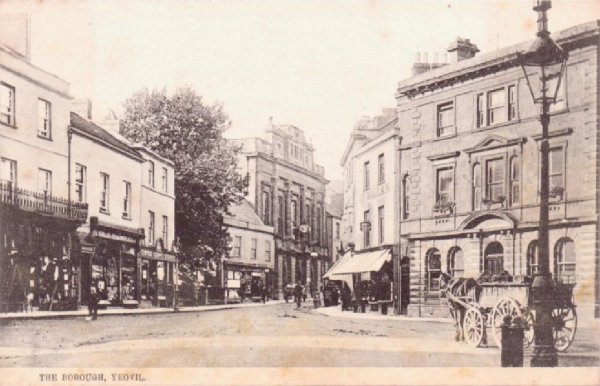
This postcard of the Borough dates to about 1905 and shows the former George Inn, or at least its site, at centre, between the tree and the Town Hall. The shop to the left of the tree was the grocery shop of Walter Sawtell. To its left was the shop of Robert Damon and at far left was that of Edmund Damon.
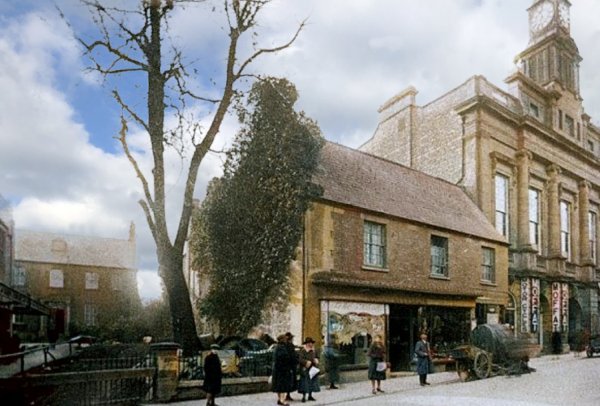
This colourised photograph of about 1915 shows the former George Inn, or at least its site, at centre, with the former Bell Inn, at left, set well back from High Street. By the time of this photograph the building was called Borough House and was used as municipal offices. The tree and shop at centre are in the position of where King George Street now joins High Street and the tall building at right is the old Town Hall (built in 1849) with its tower and gas-illuminated clock, installed in 1912. The Town Hall was destroyed in 1935 by a fire believed to have been caused by paper rubbish blowing into the tower and ignited by the gas jets illuminating the clock.
owners / tenants / licensees
1664 – Mr Thomas Phellps (poor
Rate Extracts)
Burrow, 3s 0d
for the George
and Crown (ie
the
George Inn
and the Crown
Inn)
1664 – Mr John
Cary (Poor Rate
Book) 3s 0d at
the George,
listed in the
Burrow
1677 – James
Parkes
1679 – Saml.
Prowse (Poor
Rate Book)
2s 0d at ye
George, Burrow
1684 –
William Phelps'
will
1689 – Mr Prowse
(Poor Rate Book)
9d for the
George
1694 – Samuel
Prowse (Poor
Rate Book)
listed as the
George, Borrough
1735 – Jno. King
(Poor Rate Book)
listed as ye
George, Borough
1759 –
Samuel
Kitson
(Insurance
Policy)
1770 – Samuel
Kitson, Humphrey
Spry, Matthew
Edmonds, Mary
Lacy and Thomas
Paine - see
Documentation
below.
From an
indenture of 5
December 1839
in my collection
-
"... formerly in the possession of John Phelps afterwards of Thomas Phelps then of Elizabeth Phelps Widow John Tinney and
Elizabeth
his wife
Mary
Phelps
and Ann
Phelps
since of
Nathaniel
Butler
Batten
afterwards
of
Benjamin
Beaton
the
elder
since of
Benjamin
Beaton
the
younger
then of
the said
Martha
the wife
of the
said
Thomas
Lockyer
(formerly
Martha
Beaton)
late of
the said
Thomas
Lockyer
and
Martha
his wife
and now
of the
said
James
Curtis
...".
![]()
1826 to 1839 -
James Curtis'
saddle & harness
workshop and
shop
1840 to 1850 -
George Crocker's
ironmongery
1851 to 1869 -
James Corfield's
ironmongery
1869 to 1892 -
Denner & Stiby's
ironmongery
1892 to ???? -
James
Llewellyn's
florist and
grocery
1927
- purchased by
the corporation
and demolished
for King George
Street.
Documentation
|
1568 |
A
peale on
all ye
Bells ye
24th
daye of
October
givinge
by
Master
Penye at
ye
George -
xijd.
(12d.)
(Churchwardens'
Accounts) |
|
1664 |
Burrow -
Mr John
Cary att
George,
3s.
(Poor
Rate
Book) |
|
1669 |
Rec. of
Frauncis
Keymer
for his
Fyne
upon an
Estate
in a
plott of
ground
lyinge
next the
George
Inn
called
Hacker's
plott -
£5.0.0.
(Portreeve's
Accounts) |
|
1669 |
Itm. Recd. of Frauncis Keymer for the rent of his tenement there - £0.16.0. (Rents of Assize in High Street) |
|
1679 |
'Burrow' - Saml. Prowseat ye George - 2s. (Poor Rate Book) |
|
1689 |
'Borough' - Mr Prowse for the George, Henry Lavor for the Crown - 2s. (Poor Rate Book) |
|
1694 |
'Borrough' - Samuel Prowse for the George - 9d. (Poor Rate Book) |
|
1735 |
Borough - Jno. King of ye George 2½d. (Poor Rate Book) |
|
1759 |
Thomas Atkins, late Lang - Notes of LC Hayward. Policy dated 30 July 1759 - £300 insurance transferred to brewer Samuel Kitson. (Sun Fire Office, London) |
|
1770 |
Mortgage - £85.5s.6d. - 24 November 1770 - Samuel Tomes of Yeovil, farrier, and Samuel Kitson of Yeovil, maltster, Dwellinghouse or inn called the George Inn or alehouse with garden and backside in the Hog Market (Princes Street) now in the possession of Humphrey Spry, Matthew Edmonds the younger, Mary Lacy and Thomas Paine. |
| 5 Dec 1839 indenture |
"... formerly in the possession of John Phelps afterwards of Thomas Phelps then of Elizabeth Phelps Widow John Tinney and Elizabeth his wife Mary Phelps and Ann Phelps since of Nathaniel Butler Batten afterwards of Benjamin Beaton the elder since of Benjamin Beaton the younger then of the said Martha the wife of the said Thomas Lockyer (formerly Martha Beaton) late of the said Thomas Lockyer and Martha his wife and now of the said James Curtis ...". |